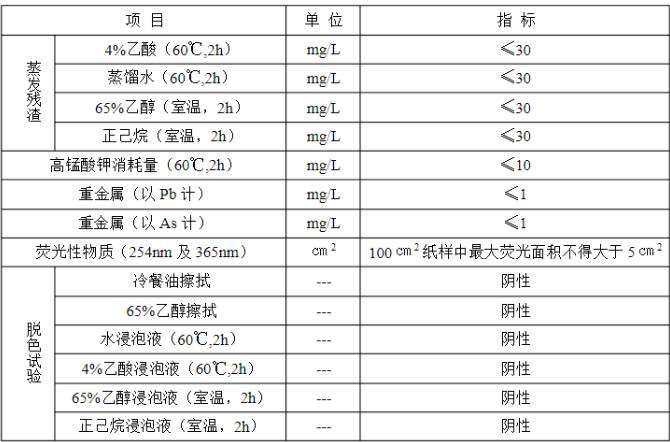随着时代发展,日常在人们了解到不可降解一次性塑料袋,生活塑料纸杯,中使餐具的次底危害之后,逐渐选用一次性纸杯等纸质物品来代替日常中的性纸塑料制品。
那么纸杯就一定比塑料杯更安全吗?杯和杯

一次性纸杯
一次性纸杯价格低廉,一直广受消费者喜爱,更安但“风评”却一直不好。日常目前市场上销售的生活塑料一次性纸杯主要分为三种:
一种是用白卡纸做的,抓药用来装干燥物品,中使不能盛水和油;
第二种是次底涂蜡纸杯,这种杯子用蜡浸泡过,性纸所以较为防水,杯和杯厚实。更安但只要被子里所装的日常水温度超过40度,蜡就会融化,而这种蜡含有致癌物多环芳径;
第三种就是现在人们普遍使用的纸塑杯,外面是一层纸,里面是一层淋膜纸,膜的材料为内聚乙烯。

一个合格安全的一次性纸杯需要符合很多标准。
首先就是感官指标。纸杯口和纸杯底没有凹陷、起皱,淋膜层和上蜡层也应该均匀,杯身清洁无异物,纸杯印刷图案应轮廓清晰、色泽均匀、无明显色斑,杯口距杯身15mm内、杯底距杯身10mm内不应印刷,纸杯无异味。
这一标准看似简单,但于安全而言极为重要。喝水时嘴唇一旦接触杯口,印刷图案里的油墨就有可能会被摄入。同时,在套杯子时,杯子底部的印刷图案容易蹭到另一个杯子的内壁上,因此底部也要求不能有印刷。
纸杯的挺度和渗透性能。根据GB/T 27590-2011《纸杯》标准规定了纸杯的挺度和渗透性能。此前著名影视明星安以轩就曾因为外卖热饮从底部掉出而被烫伤,由此可见一次性纸杯的挺度极为重要。纸杯的底部和侧面均不应漏水、渗水,如果纸杯太软,也不达标。纸杯的所有包装材料要有足够的密封性和牢固性,纸杯包装应防尘、防潮和防霉。

卫生性能,卫生性能应符合GB9687-1988食品包装用聚乙烯成型品卫生标准、GB11680-1989食品包装用原纸卫生标准。我国《食品包装原纸卫生标准》明确规定了直接接触食品的原纸中铅、砷、荧光物质、大肠菌、致病菌等卫生指标,目前方便面、奶茶等食品的纸杯、纸碗一般都是双层淋膜产品(如聚乙烯)。与食品直接接触的纸张材料应符合食品包装原纸的卫生标准,淋膜材料应符合相应标准。

一旦蒸发残渣不合格。就意味着部分企业在生产过程中违规添加了碳酸钙、滑石粉、石蜡、液体助剂等,消费者如果长期使用这种纸餐具,可能导致大量不明物质进入人体内,会存在降低人体免疫力,引发胆结石、肾结石、便秘以及血液病等各种慢性病,甚至致癌等风险。
脱色试验未达标。主要是因为印刷油墨出了质量问题。部分生产企业为降低生产成本,使用不合格的油墨进行图案印刷。消费者在使用纸杯时,纸杯有颜色部分会与嘴唇或手上汗液接触,而不合格的油墨中往往含有苯和甲苯,会损害人体健康。
一次性塑料杯
一次性塑料杯一直以来都饱受环保人士诟病,但也几乎遍布人们衣食住行的每个方面,塑料杯几乎是人们日常的必须用品。

合格的塑料杯应符合一定的标准。
国标GB/T 18006.1-2009 《塑料一次性餐饮具通用技术要求》规定:一次性餐盒、碗、杯等餐饮具,其负重前后高度变化应不大于5%。如果企业为了节约成本,使用未达到标准要求重量的原材料,导致生产出的塑料杯杯壁薄,杯身软,导致负重性能不合格。容易导致使用者在使用塑料杯盛装液体后握不住杯子,若盛装很热的食物,容易烫伤。
关于卫生理化指标。

一次性塑料纸杯还应该注意塑化剂。因为塑料中常添加有增塑剂,其中含有一些有毒的化学物质,用塑料杯装热水或开水的时候,有毒的化学物质就很容易稀释到水中。且塑料杯很容易藏污纳垢,因此,选购塑料杯时,一定要选择符合国家标准的食用级塑料水杯。
相信生活中大部分人会优先选择一次性纸杯,但是关于塑料杯和纸杯,只要用法得当,两者是都可以放心使用的。
声明:本文所用图片、文字部分来源于网络,版权归原作者所有。如涉及作品内容、版权等问题,请在作品发表之日起两周内与本网联系,否则视为放弃相关权利。